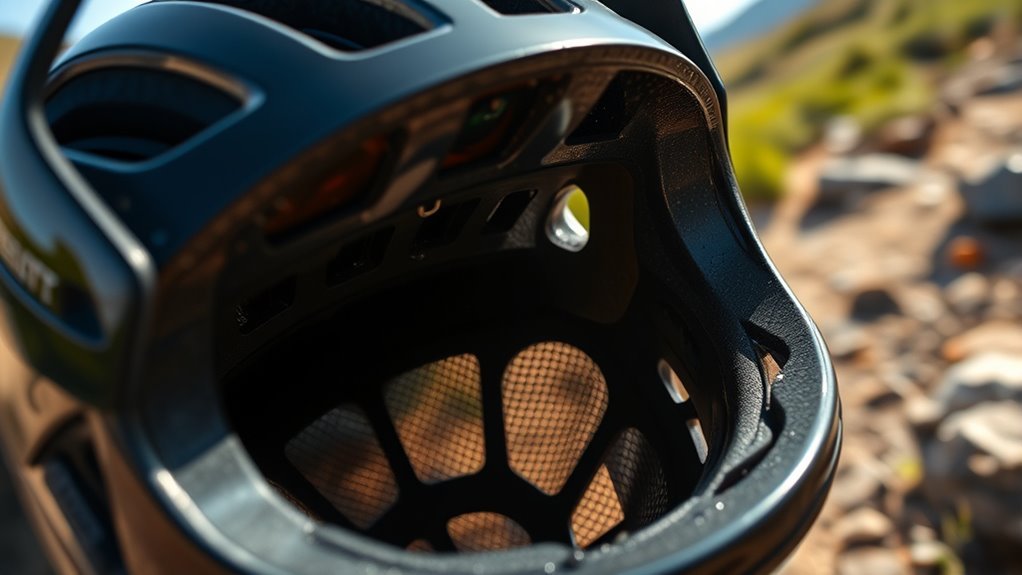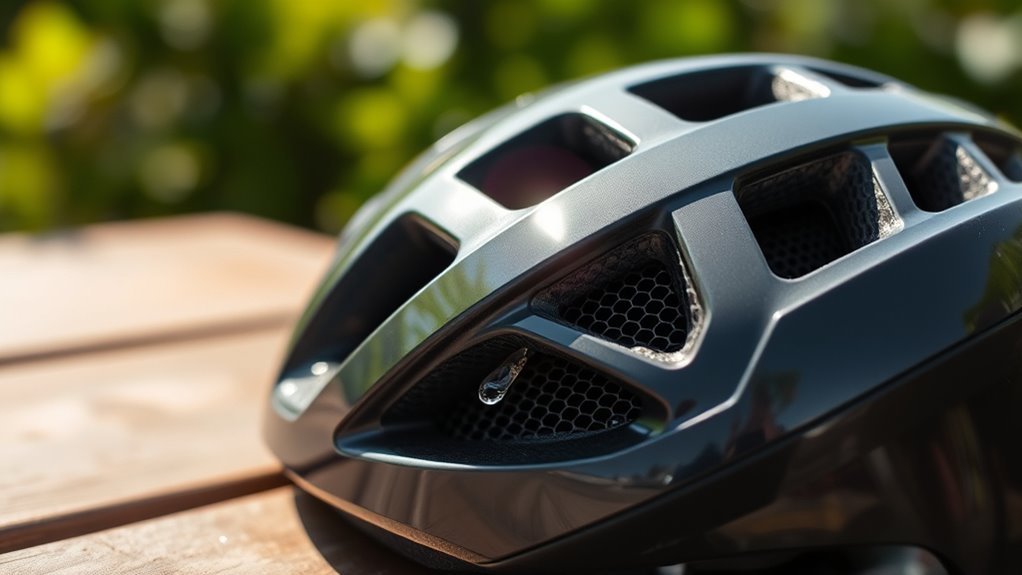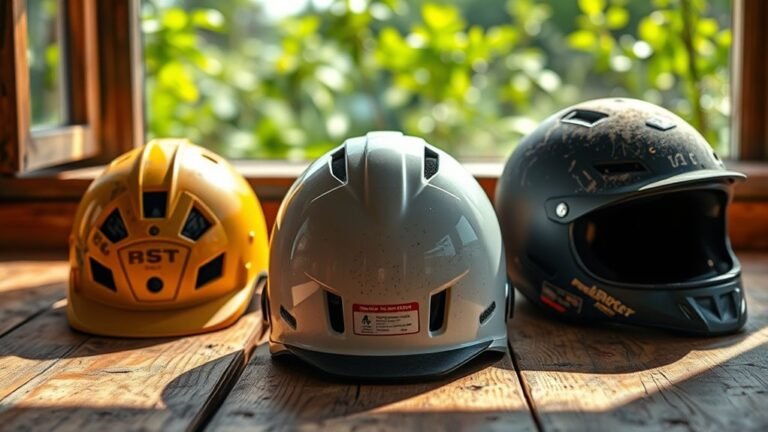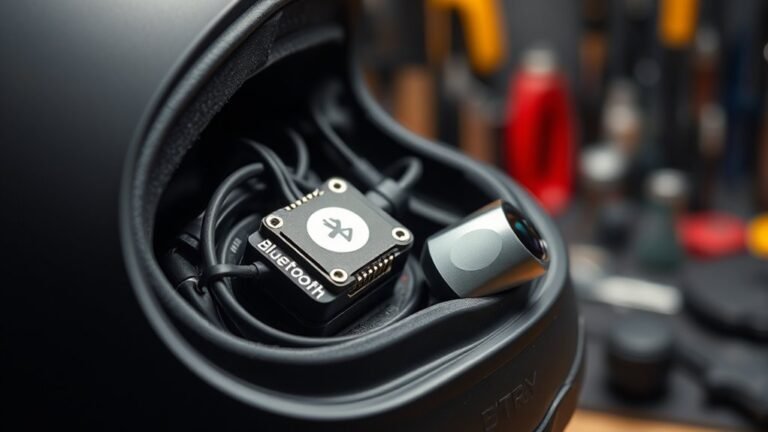Maintaining Helmet Ventilation for Comfort
To maintain helmet ventilation for comfort, guarantee your helmet fits snugly, allowing proper airflow. Look for adjustable vents to control air circulation according to weather and activity levels. Clean your helmet regularly, especially around vents, to prevent debris buildup that can obstruct airflow. Choose a design with adequate ventilation ports and lightweight materials for peak comfort. Proper maintenance enhances performance and safety. Let’s explore further strategies to maximize your helmet’s ventilation efficiency.
Understanding Helmet Ventilation

When you’re wearing a helmet, understanding how ventilation works is essential for comfort and safety. Ventilation technology is key to managing airflow dynamics within the helmet. Proper airflow helps regulate temperature and moisture, reducing discomfort during prolonged use. Helmets often feature strategically placed vents that promote effective air circulation, allowing fresh air to enter while expelling hot, stale air. This design not only enhances comfort but also minimizes fatigue and distraction. Pay attention to the positioning and number of vents, as these factors greatly influence ventilation efficiency. By grasping how airflow dynamics interact with your helmet’s structure, you can make informed decisions about your gear, ensuring you enjoy your ride to the fullest while staying cool and comfortable.
Choosing the Right Helmet Design

Selecting the right helmet design involves understanding how various features impact both ventilation and overall performance. Your choice should reflect a balance between comfort and function, especially if you value freedom in your activities. Consider these elements:
- Aerodynamic features: Streamlined shapes reduce drag, enhancing airflow.
- Ventilation ports: Strategically placed openings improve air circulation and cooling.
- Material selection: Lightweight materials can increase comfort without sacrificing safety.
- Padding configuration: Different padding arrangements can optimize airflow while providing necessary cushioning.
Ensuring Proper Fit for Ventilation

Although a helmet may boast excellent ventilation features, its effectiveness hinges on achieving a proper fit. To guarantee ideal airflow, you need to make precise fit adjustments. Start by measuring your head circumference and consulting the manufacturer’s sizing chart. Once you’ve selected the right size, pay attention to the padding placement inside the helmet. The padding should sit snugly against your head without causing discomfort. If the helmet feels loose, adjust the retention system or swap out the pads for thicker ones. A well-fitted helmet not only enhances ventilation but also maximizes safety. Remember, a helmet that shifts or moves can disrupt airflow, making it essential to achieve a balance between comfort and stability for the best riding experience.
Utilizing Adjustable Vents
Achieving a proper fit guarantees that any ventilation features, including adjustable vents, work effectively. These customizable vents allow you to control the adjustable airflow in your helmet, enhancing comfort during rides. When you adjust the vents, you can fine-tune the temperature and moisture levels inside, providing a more enjoyable experience.
- Temperature Regulation: Adjust vents according to weather conditions.
- Moisture Management: Control humidity for a drier feel.
- Airflow Customization: Match airflow to your activity level.
- Personal Comfort: Tailor ventilation to your specific preferences.
Keeping Your Helmet Clean
Keeping your helmet clean is vital for both hygiene and performance. Dirt, sweat, and grime can accumulate in the interior, impacting helmet hygiene and reducing ventilation efficiency. Start by removing any removable liners and padding, as these can be washed separately. Use a mild soap and water solution to clean the exterior, avoiding harsh chemicals that could damage the materials. Pay special attention to the vents; keeping them free of debris is essential for effective ventilation maintenance. After cleaning, thoroughly dry all components before reassembling. Regular cleaning not only enhances comfort but also prolongs the lifespan of your helmet. Make it a habit to inspect and clean your helmet after every ride for ideal performance and hygiene.
Using Cooling Accessories
Cooling accessories can considerably enhance your comfort during rides, especially in warmer conditions. By integrating these tools into your helmet setup, you can optimize airflow and reduce heat buildup. Here are some effective options:
Enhance your riding comfort with cooling accessories that optimize airflow and reduce heat buildup in warmer conditions.
- Cooling pads: These absorb heat and wick moisture away, maintaining a comfortable temperature.
- Helmet liners: Specialized liners can enhance ventilation and provide a snug fit, improving overall airflow.
- Cooling towels: Wearing these around your neck can lower your body’s temperature, indirectly benefiting your helmet experience.
- Ventilation inserts: Some helmets allow for additional inserts that improve airflow, promoting cooling without compromising safety.
Utilizing these cooling accessories not only enhances comfort but also allows you to enjoy your rides with greater freedom and confidence.
Dressing for the Weather
When you dress appropriately for the weather, you can greatly enhance your riding experience and guarantee safety. Understanding the weather conditions is vital; temperature fluctuations and precipitation can impact both comfort and performance. Employing effective layering strategies is essential. Start with a moisture-wicking base layer that keeps sweat away from your skin, followed by an insulating layer to retain warmth. Finally, add an outer shell that protects against wind and rain without restricting airflow. This combination allows for ideal ventilation within your helmet while maintaining comfort. Remember, flexibility in your layers means you can easily adjust to changing conditions, ensuring you stay focused on the ride ahead, not on discomfort. Dress smart, ride free!
Regularly Inspecting Your Helmet’s Ventilation System
Regular inspections of your helmet’s ventilation system are essential for peak performance and comfort during rides. Conducting a thorough vent inspection guarantees maximum airflow and reduces discomfort. Here’s what you should focus on during your airflow assessment:
- Check for Blockages: Verify vents are clear of dirt, debris, or insects.
- Inspect Padding: Look for wear that could obstruct airflow.
- Test Vent Functionality: Open and close vents to confirm they operate smoothly.
- Assess Overall Fit: A poorly fitting helmet may compromise ventilation efficiency.
Frequently Asked Questions
How Often Should I Replace My Helmet for Optimal Ventilation?
You should replace your helmet every 3 to 5 years for ideal ventilation efficiency, as the helmet lifespan can diminish due to wear and tear. Over time, materials break down, impacting how well the helmet ventilates and protects you. If you’ve been in a crash or noticed a decrease in airflow, it’s best to upgrade sooner. Keeping your helmet in peak condition guarantees you enjoy both safety and comfort during your rides.
Can I Modify My Helmet’s Ventilation System at Home?
You can modify your helmet’s ventilation system at home, but it’s vital to do so carefully. DIY helmet adjustments might improve airflow, but any alterations can compromise safety. Consider ventilation modifications like adding vent holes or using lighter materials. However, always guarantee your changes don’t weaken structural integrity. Test any adjustments thoroughly before use, and remember, a well-ventilated helmet should still meet safety standards for peak protection during your rides.
What Materials Improve Helmet Ventilation Performance?
To boost your helmet’s ventilation performance, consider using advanced materials like mesh fabrics and lightweight foams. These ventilation materials dramatically enhance airflow dynamics, creating a revitalizing breeze inside your helmet. Think of it as turning your helmet into a personal wind tunnel! Also, incorporating moisture-wicking liners can help keep you dry and comfortable. Remember, the right materials can transform your riding experience, giving you the freedom to focus on the ride, not the heat!
Do Different Activities Require Different Helmet Ventilation Features?
Yes, different activities require distinct helmet ventilation features. For mountain biking, you’ll need a helmet with larger vents to accommodate the high-intensity movement and varied terrain, allowing for ideal airflow. In contrast, road cycling demands a more aerodynamic design, often with smaller vents to reduce drag while still ensuring sufficient ventilation. Choosing the right helmet based on your activity enhances comfort and performance, giving you the freedom to fully enjoy your ride.
Are There Helmets Specifically Designed for Humid Climates?
Yes, there are helmets specifically designed for humid climates. These helmets utilize advanced ventilation technology to enhance airflow, reducing moisture buildup and promoting comfort. Additionally, they often feature humidity resistance materials that help wick away sweat, keeping you dry during intense activities. When selecting a helmet, look for models that prioritize these features to guarantee you can enjoy your ride without being weighed down by heat and humidity.






